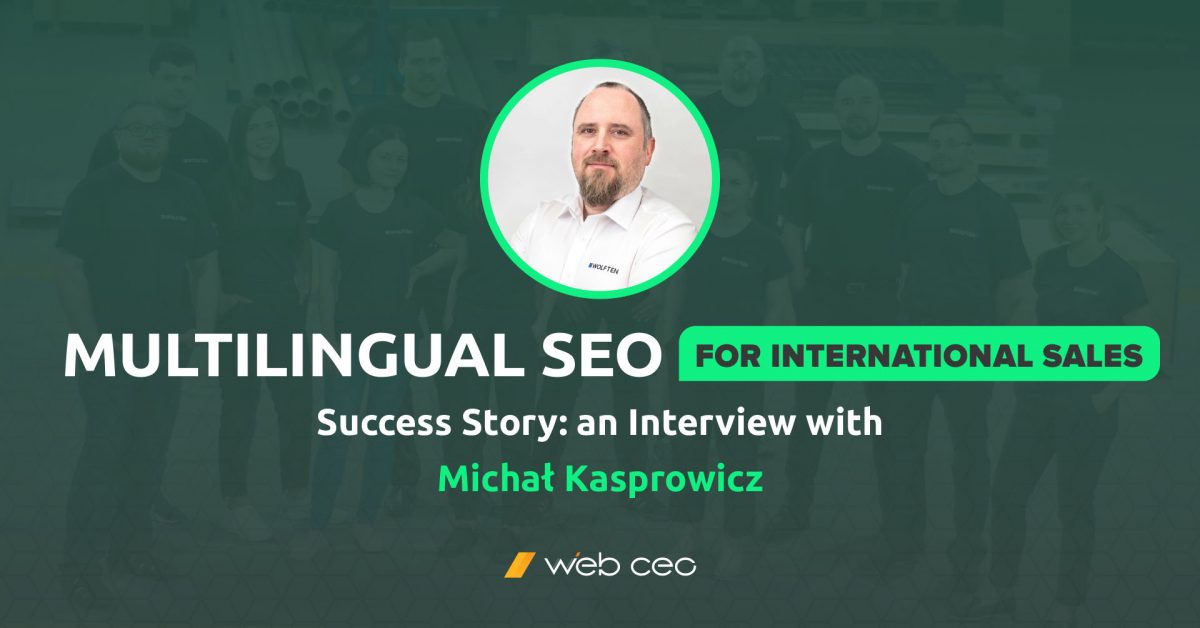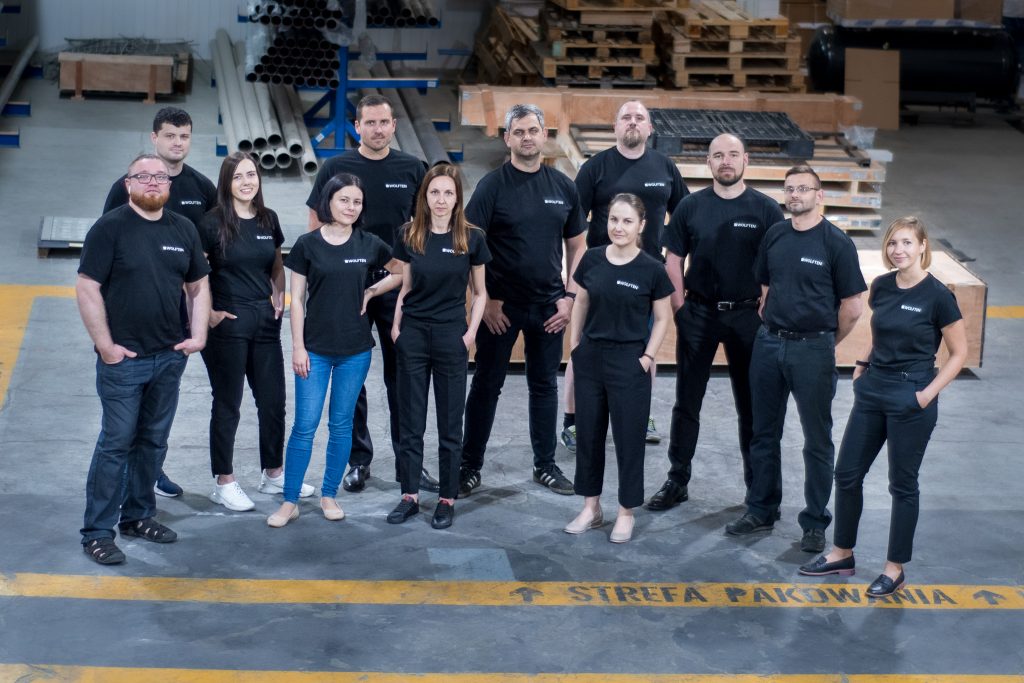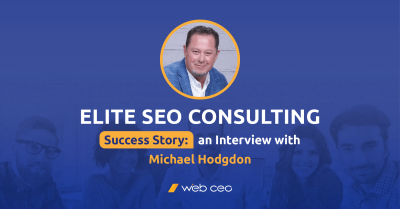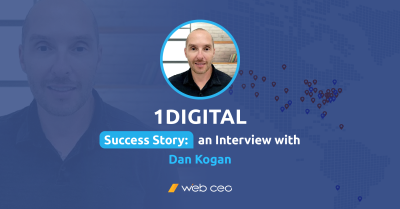
Local SEO is definitely trending now, especially now when many companies have realized that turning to other local markets worldwide could help them scale up their businesses and stay afloat in a post-covid world.
We recently posted an ultimate Local SEO Guide that covers all must-do tasks in a comprehensive step-by-step way.
Today we are talking with Michał Kasprowicz,a Business Development Manager for Wolften, an international company that caters alloy materials to several European countries. Michał has been a customer of WebCEO for more than a decade, and now he shares his story with fellow marketers and those who are considering covering new markets but who need an inspiring example to get the ball rolling.
Joanne Pimanova: Michal, when did you come to the idea that you need a multilingual website? What made you take this decision? What were the technical challenges?
Michal Kasprowicz: We thought of a multilingual website for a long time. For the past few years, our English and German versions served more as a courtesy rather than a serious source of business, however we gained some business leads from them.
With ever-changing and sometimes unpredictable situations on the market (the Covid pandemic being one of them), business owners started to think more about minimizing the risks related with sudden fluctuations in business. Hence, for us, international expansion became a key strategy not only to prevent a potential crisis, but also to gain valued and long-term business partners and keep the business stable.
We laid the first cornerstone of the international presence of our company online.:)
The first thing was to evaluate what our customers may be looking for, how they look for specific products and information, and what other companies and competitors do to serve their clients. We compared that data with what we already know about our Polish customers, at home. With that info, we were able to sketch our first draft of the strategy.
Joanne: How long did it take to launch your site in 3 more languages? How many pages did you translate?
Michal: We continually work on our web presentation. The website is something that will never be finished – sure, we conclude certain projects, but we keep working on new ones.
Our web presentation (or any web presentation, I should say) can be divided into two main parts: the part that we need and is necessary for our customers and operations (this makes approximately 70% of overall content) and the part that is a nice addition, “nice-to-have” feature with more information.
Obviously, the first part needed to be translated before launching any activities in a new country, but eventually we are going to have ALL information in ALL languages.
We are now concluding our Russian language version and it will also be a challenging project to promote and optimize Russian content to our potential customers in Russia.
Joanne: You sell specific stuff, high-quality alloy materials. Did you translate your content to English, Czech and German languages with the help of the Google Translate service? Or, did you translate it all by yourself?
Michał: I wrote and translated everything myself. For the past 12+ years, I’ve been a freelance translator working with the EN, PL and CZ languages. I lived and studied in the Czech Republic. I learned the language and I understand both the proper grammar and a “spoken”, colloquial language. I wouldn’t recommend using any automated translation to translate websites. Even though the quality of machine translations has improved significantly over the years, I believe human translation is a crucial issue and should be treated as seriously as possible. You can’t sell your products with poor language. Unique, good quality texts are also very important for SEO purposes. Uncle Bill once said “content is king”!
Even though the quality of machine translations has improved significantly over the years, I believe human translation is a crucial issue and should be treated as seriously as possible. You can’t sell your products with poor language.
I still remember when one of the biggest online auction companies with the most popular and innovative website in the world (I intentionally don’t state their name) tried to launch their operations in Poland several years ago. They failed! Why? Because they neglected the local aspect of their business. Their Polish version of the website was translated very poorly, with the majority of the crucial information either in English or just translated in such a way that puts a smile on a Polish native speaker’s face. Would you trust such a website? Would you pay for the product if you can’t really understand the terms and conditions?
Well, we definitely do not want to make such a mistake.
Joanne: Wow cool, you are really a versatile person! I also agree that you can’t sell products with poor language and that it’s critical to understand the mentality of a new market that you are approaching. Let’s talk about technology.
Were you choosing between:
(a) buying several country-specific domains,
(b) creating several subdomains on one domain, or
(c) creating several country-specific directories under the same domain?
Or, was the “directories” technology your first and most obvious choice?
Michał: We have local, country specific domains for the Czech (wolften.cz), Slovak (wolften.sk) and German (wolften.de) markets, but we mainly focus and base everything on one, main domain: wolften.pl, so I would choose option “c” from your list.
Joanne: Do you do any kind of local SEO? Or, was it enough to translate your site to 3 more languages?
Michał: Yes, we do local SEO. Understanding the product and conducting proper market research supported by solid data gave us an understanding of how to approach the new markets and how to optimize our landing pages to get the best results. It is never enough just to translate the website as Google changes its algorithms and one should keep an eye on what is going on with specific landing pages, how they show in SERPs and what the competition does.
Also, we never underestimate what our customers say, what they look for and how easy or difficult it is for them to find information on our website. But even with the best texts in any local language, with the best product description and well optimized landing pages, we cannot forget to properly treat those clients who do find us – providing customer service in their native language is an important aspect that marks our success. A disappointed client is the worst thing that can happen, so we also make sure that we serve our clients in the language they see on our website.
Joanne: If you do local SEO – what tasks do you regularly do? Do you track local rankings from several locations?
Michał: We approach local and global SEO with equal passion and try not to differentiate whether it’s the Czech or Polish market or the International Arena. Tracking our local rankings happens every two to three days.
An analysis of web traffic to each language version happens every day, all the time. We also try to make our website alive, by writing new content and improving and expanding the information on it.
Also, it is good to step back and look at the things with perspective: compare the results from each location and find patterns, similarities and trends that just wait to be explored. I always try to learn from the results.
A vast majority of automated tasks are done by WebCEO, which helps us to prioritize the tasks and focus on important aspects of SEO and online promotion.
Joanne: Have you registered your business in GoogleMyBusiness? Does your GMB profile help you to get more traffic and sales?
Michał: Yes, we do use Google My Business which helps us to get local traffic and reach local customers, my plan is to focus on that tool more in the future and see how it can help us gain international customers.
It is important to emphasize that our business is very specific as we work with a very homogeneous market. We also have a slightly different clientele compared to a typical online retailer, as the purchases for our products are not emotional or impulse-based. We do not use typical marketing strategies as our products are not “the best” … well.. of course they are!! 😉 but our titanium sheets are not “the strongest” nor do they shine more than those sold by other companies.
It’s important to us to have better rankings rather than huge traffic to the website. People don’t look for tungsten spherical powders for 3D printing on a daily basis, but when they eventually do, we want to be at the top of the list.
Joanne: Did you see the difference after you implemented a multi-language website?
Michał: Of course 🙂 Launching a website in a new language is one thing and optimizing and promoting it is another. The fact is, that within the first week after implementing our website and receiving the first visitors to the new language version, we got the first tangible (what can be more tangible than titanium alloys, huh? 😉 orders and the amount of requests jumped through the ceiling. For more details and figures – we still need to wait for and evaluate the results from a wider perspective.
Within the first week after implementing our website and receiving the first visitors to the new language version, we got the first tangible (what can be more tangible than titanium alloys, huh? 😉 orders and the amount of requests jumped through the ceiling.
Joanne: How does WebCEO help you with your work?
Michał: WebCEO helps to organize the tasks, the workflow and provides hints and tips related with technical issues. If I was to do it manually, using only a spreadsheet, it would take me months to analyze my website and what is going on with it.

Joanne: Have you tried other SEO platforms? What was the decisive factor that made you choose WebCEO?
Michał: Of course, I tried a lot of them. I also had a short romance with IPB (I think they are Germans or Austrians), but for some reasons the software got more complicated and since they were only a desktop version, I started to look for web based solutions.
Joanne: Michał, what is your global mission?
Michał: We want to become a global (European) leader in special alloys. That’s quite a heavy (literally) and hard (literally) thing to do, but with the proper SEO approach, online presence is the key to success. Sophisticated web presentation and easy-to-find information helped us to expand and grow and we want to keep it that way.
Since special alloys are not the most popular and frequently-purchased products, we are currently working on an e-commerce solution to reach out and gain new customers. Also, new language versions to the website (we currently have PL, CZ and EN) will also be a new task. Interestingly enough, WebCEO helps me to work with all language versions at the same time!
Joanne: Can you give 3 pieces of advice to those who are planning to run a multi-language website?
Michał:
– understand your clients in other (targeted) countries;
– do not try to think for your clients. Accept and understand that people in country A may have different preferences and a different approach than people in county B;
– be patient and draw conclusions from the results.
Joanne: Thanks a lot for your input, Michał! I am sure many of your insights will serve as a decisive factor to those who are still hesitating on whether it’s worth scaling up their business and facing new markets by going multilingual. I wish you great success in your business and openings to more countries in the nearest future!


